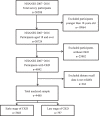Associations between dietary patterns and stages of chronic kidney disease
- PMID: 35317735
- PMCID: PMC8939097
- DOI: 10.1186/s12882-022-02739-1
Associations between dietary patterns and stages of chronic kidney disease
Abstract
Background: Studies have revealed that patients with chronic kidney disease (CKD) have dietary patterns different from those of the general population. However, no studies have compared the dietary patterns of between patients with early-stages (stages 1-3a) and late-stages (stages 3b-5) of CKD. Our objective was to investigate the associations between dietary patterns in early and late-stage CKD.
Methods: We analyzed 4480 participants with CKD at various stages based on the data recorded between 2007 and 2016 from the database of the American National Health and Nutrition Examination Survey.
Results: In total, 3683 and 797 participants had early and late-stage CKD, respectively. Through principal components analysis, the dietary intake dimension was reduced from 63 variables to 3 dietary patterns. We adopted logistic regression for analysis. The three dietary patterns are as follows: (1) saturated fatty acids and mono-unsaturated fatty acids (MUFA); (2) vitamins and minerals; and (3) cholesterols and polyunsaturated fatty acids (PUFA). These 3 patterns explained > 50% of dietary nutrient intake. Results indicated that among participants with dietary patterns 2 (vitamins and minerals) and 3 (cholesterols and PUFA), those with low intakes were more likely to have late-stage CKD. The odds ratios for patterns 2 and 3 were 1.74 (95% CI: 1.21-2.50) and 1.66 (95% CI: 1.13-2.43), respectively.
Conclusions: This study revealed that intakes of vitamins and minerals and cholesterols and PUFA were associated with the stages of CKD.
Keywords: Chronic kidney disease; Dietary pattern; Nutrient intake; Stage.
© 2022. The Author(s).
Conflict of interest statement
No competing interests were declared.
Figures



Similar articles
-
Association of Dietary Intakes and Genetically Determined Serum Concentrations of Mono and Poly Unsaturated Fatty Acids on Chronic Kidney Disease: Insights from Dietary Analysis and Mendelian Randomization.Nutrients. 2022 Mar 15;14(6):1231. doi: 10.3390/nu14061231. Nutrients. 2022. PMID: 35334888 Free PMC article.
-
Dietary patterns, plasma vitamins and Trans fatty acids are associated with peripheral artery disease.Lipids Health Dis. 2017 Dec 28;16(1):254. doi: 10.1186/s12944-017-0635-y. Lipids Health Dis. 2017. PMID: 29282129 Free PMC article.
-
The Combined Effects of the Most Important Dietary Patterns on the Incidence and Prevalence of Chronic Renal Failure: Results from the US National Health and Nutrition Examination Survey and Mendelian Analyses.Nutrients. 2024 Jul 12;16(14):2248. doi: 10.3390/nu16142248. Nutrients. 2024. PMID: 39064691 Free PMC article.
-
Dietary fat modification in patients with chronic kidney disease: n-3 fatty acids and beyond.J Nephrol. 2013 Nov-Dec;26(6):960-74. doi: 10.5301/jn.5000284. Epub 2013 Oct 3. J Nephrol. 2013. PMID: 24249210 Review.
-
Vitamin status and needs for people with stages 3-5 chronic kidney disease.J Ren Nutr. 2011 Sep;21(5):355-68. doi: 10.1053/j.jrn.2010.12.004. Epub 2011 Mar 25. J Ren Nutr. 2011. PMID: 21439853 Review.
Cited by
-
The Effect of Omega-3 Supplements on Renal Function Indices in Chronic Kidney Patients Undergoing Hemodialysis.Nutr Metab Insights. 2025 Jun 27;18:11786388251345518. doi: 10.1177/11786388251345518. eCollection 2025. Nutr Metab Insights. 2025. PMID: 40584465 Free PMC article.
-
Statin Therapy and Lipid Indices in Chronic Kidney Disease: A Systematic Review and Meta-analysis of Randomized Control Trials.Curr Pharm Des. 2024;30(5):362-376. doi: 10.2174/0113816128285148240122112045. Curr Pharm Des. 2024. PMID: 38288799
References
-
- Chronic Kidney Disease (CKD) Surveillance System. https://nccd.cdc.gov/CKD/. Accessed 16 March 2022.
-
- Go AS, Chertow GM, Fan D, McCulloch CE, Hsu CY. Chronic kidney disease and the risks of death, cardiovascular events, and hospitalization. N Engl J Med. 2004;351(13):1296–1305. - PubMed
-
- Tonelli M, Pannu N, Manns B. Oral phosphate binders in patients with kidney failure. N Engl J Med. 2010;362(14):1312–1324. - PubMed
Publication types
MeSH terms
Substances
LinkOut - more resources
Full Text Sources
Medical

